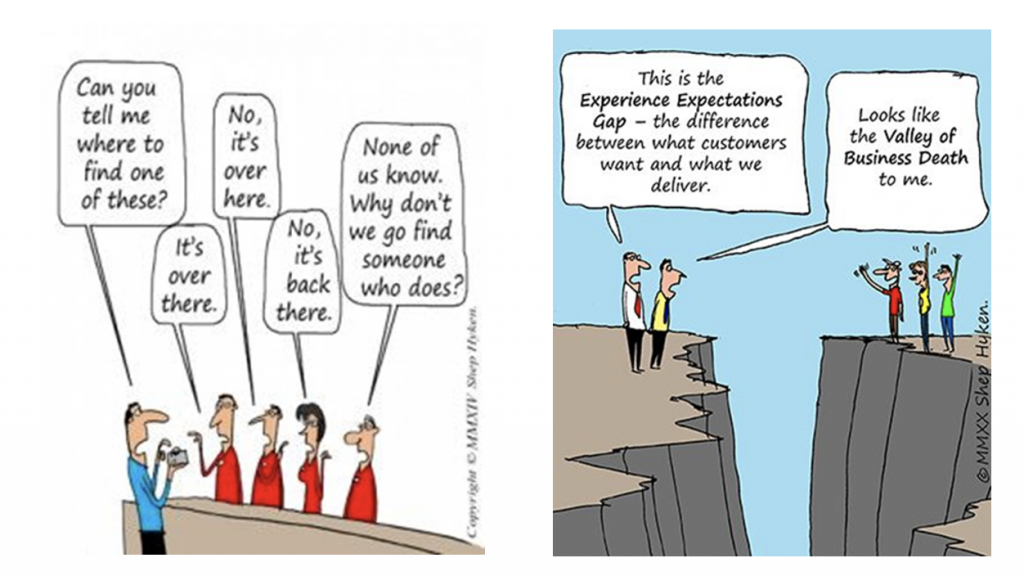
Customer service occurs by phone, email, live chat, social media, SMS as well as face-to-face. Regardless of which of the above communication channels customers use, they all want the same thing: High-quality support (service).
When was the last time you received good customer service or gave one?
Within our respective service establishments, we must know our customers/guests, to know what they want. Do we truly understand our customers’ needs? Have we built how we intend to meet their needs into our operational systems?
Different service establishments have their areas of specialization but the common denominator is SERVICE, high-quality support.
There are different meanings attached to service. Using my bias in hospitality, in last week’s feature, I opted for the formula:
SERVICE=Fulfilment of a need (RESULT) + the sum of all touchpoints (EXPERIENCE)
Making customers FEEL SERVED requires CONNECTING WITH THEM TO DELIGHT THEM while meeting their needs and expectations. The first cartoon below depicts the contrary. Acknowledging the customer service challenge, as in the second cartoon, is the first step toward correcting service mishaps.

Last week’s feature highlighted how we can use our unique service environments in creating the ideal customer/guest experience: creating a welcoming, informative, entertaining and caring, hassle-free environment.
However, we cannot effectively create the above environments without a good grasp or understanding of the characteristics of service.
Students pursuing hospitality operations management and marketing professionals within the service space are too familiar with the unique nature of service as:
- Intangible: you cannot hold, touch, taste, or smell it.
- Inseparable: production and consumption occur simultaneously.
- Perishable: you cannot store, save, return or resell it once the service is used.
- Inconsistency: There can be no perfect standardization of services.
- Heterogeneity/variability: Variations in service even by the same service provider.
- Difficulty in measuring output.
These characteristics come with several implications, among which are:
- You cannot judge the quality of service before consumption.
- Even if the service provider is the same, the quality of the service may differ from time to time.
- You cannot separate the service from the service provider.
- The customer is part of the service/customer must be involved in the service.
- Being an intangible transaction there can never be an inventory of services.
Communication and Customer Service

We don’t usually give communication a second thought. ‘After all, everyone communicates!’ Really?
Customer service is often a challenging, and demanding job, and communication is key to good customer service. At times, customer service can feel like a thankless toil job, particularly for those who struggle with communication!
Communication is very complex, and the threat of miscommunication is constantly popping up during service encounters frustrating both the customer and the service provider.
Our words, the tone of our voices, actions, gestures, the emotions we express, and even inactions as well as what we fail to say, all send messages which may be interpreted correctly or incorrectly. My general observation is the deep influence of culture on our communication habits. For example, “yes” may mean “maybe” or even “definitely” even in different English-speaking countries. I’m sure you can think of a few more.
Non-verbal communication is also important and may include anything from gestures and facial expressions to a sense of time, personal distance, and even seating arrangements, and dressing.
I’m afraid we overlook these seemingly small cultural communication habits which unfortunately send wrong signals to others of different cultural backgrounds. We must all become more conscious of our communication skills and learn to communicate more effectively to enhance our customers’/guests’ experiences.

The above are all basics to customer service.
I shall begin placing the building blocks in the coming weeks as we consider how to stimulate customer experiences and suggest skill requirements for all. In the hospitality and tourism business environment, customer service is the responsibility of all.
To be continued.

2 comments
I like the customer service bit, it is very interesting and important to most of the operators in the hotel industry, I visited one of the biggest hotels in the country. Arrived early for a group programme, requested to be placed near the conference room, but was denied with the excuse that the place has been fully booked and allocated rooms cannot be altered. Meanwhile, juniors who arrived later were placed appropriately. Very disappointed in the services. Communication by the front desk officer not professionally executed.
Thank you, Ama. Your observations show the challenge we have in service delivery is very real. Communication is a challenge for service providers.